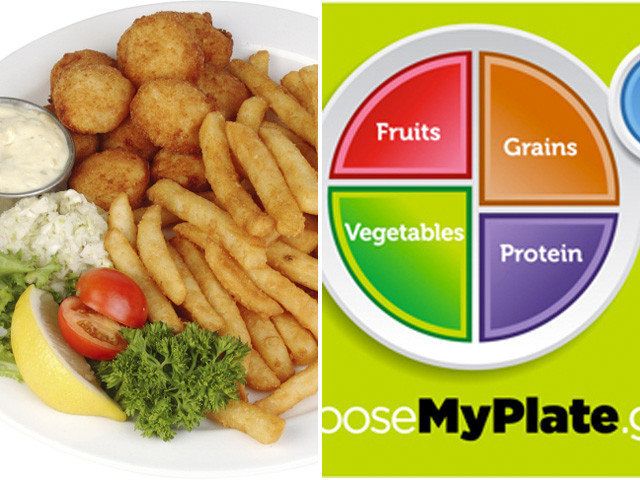
A few days ago, soon after the unveiling of MyPlate (the latest nutritional logo), my husband and I were at a museum event that included dinner. To my astonishment, the dinner, served buffet style, seemed to follow MyPlate's dietary recommendations. MyPlate replaced the old food pyramid which stacked food groups according to the relative amount that should be consumed daily. The plate is divided into four quadrants that are to be filled with relatively equal amounts of fruit, vegetables, grains and lean protein. Dairy products are off on the side in a small circle or cup. The foods with little nutritional value like pastries, bacon, mayonnaise and chocolate are nowhere in sight.
The museum meal seemed to resemble a MyPlate special. The plates were salad-size and too small to keep the four food groups in their proper sections. However, the buffet offering of salad, broccoli, cherry tomatoes, penne pasta with tiny amounts of chicken and a thin, slice of beef on top of a small corn cake would easily fill the appropriate quadrants. The greens and broccoli would fill the vegetable section, the tomatoes -- technically a fruit -- the fruit section, pasta and corn take care of the grain quadrant and the protein (chicken, steak), the protein quadrant. The caterer must have been aware that dessert did not have a place on the plate. As we were finishing our dinner, servers came around with trays containing a microscopic tart that was just big enough to hold one blueberry.
I was impressed at how easily one can figure out whether a meal contains the correct ratio of vegetables and fruit by using this model. Since one important objective of the new dietary guidelines icon is to decrease obesity by making vegetables and fruits such a prominent and visual part of the meal, this schema could be helpful.
To be sure, in order to know how much of any of these foods we should be eating, it is necessary to go to the MyPlate website and look up serving sizes for each food group according to the age and gender of the eater. However, the four-quadrant model doesn't tell us how to fit ingredients such as fats, oils, small amounts of sugar, condiments and flavor enhancers like garlic, mustard, herbs and spices on the plate. This information is also on the website but it takes time and patience to find it.
Yet the question (and the problem) that haunted the food pyramid still remains: Is knowing how to fill our plates with fruits, vegetables, grains and protein enough to make us do it? I suppose the answer is yes, with qualifiers. Yes, if the many obstacles preventing us from eating this way are minimized or removed. Here are some (mostly humorous) suggestions for doing away with some of these obstacles:
1.Since the First Lady is such a staunch supporter to this concept, the White House could change its formal dinnerware to plates divided into four sections with labels or pictures of protein, grains, vegetables and fruit. Replicas of these plates could be sold for use in schools, restaurants and home.
2. Restaurants, especially upscale establishments, should immediately stop putting vegetables and often grains and starches on their expensive a là carte menu and include them as part of the main course. Of course, in order to do this, they must also shrink the protein entrée so it covers only one quarter of the plate rather than hanging over the sides.
3.Food shows in which the host travels around to eating establishments offering humongous portion sizes of everything from pancakes to barbecue should now switch to showcasing salad bars and restaurants specializing in dishes made from whole grains, like bulgur and wheat flakes. Moreover, the individual who proves that his stomach is large enough to contain a pizza big enough to feed a wooly mammoth, must now demonstrate how many vegetables he can eat in 15 minutes.
4.Cooking shows should follow these guidelines as well. When the prepared food is plated at the end of the show, it should be divided into the four sections in appropriate amounts. Visualizing this will help the viewer figure out how to do it at home. Of course, desserts and foods made with copious amounts of egg yolks, cream, sugar, chocolate and butter so dear to some of the Food Network chefs will no longer be made. (Of course, I do not believe this will ever happen.)
5.Diets gurus who advocate obliterating the consumption of carbohydrates and many fruits in favor of fatty protein and fat will have to justify why their recommendations deviate so profoundly from the government's dietary guidelines.
6.A national panel on what to do about pizza should be convened. Since it is a dietary staple of so many, it is not going to disappear even though there is no way it can fit on the MyPlate dietary guidelines icon. Among the problems to be addressed: Should pizza boxes be reconfigured so half of the box is filled with salad and fruit? Would making an extremely thin crust out of whole wheat satisfy the grain requirement? Should the cheese be limited to a dusting of parmesan powder and lean protein like chicken used for a topping?
7.Fast food restaurants will have to deconstruct their sandwiches when they are served. For example, a Subway sandwich will be presented on a plate with each component in its place: cold cuts on one part, the roll on another, shredded lettuce, onions, tomatoes and pickles in the third. The displays selling chips will be replaced by one selling fruit, which will go into the fourth quadrant.
8.Adults who do not eat their vegetables have to stay at the table until they do so.
9.Salad bars will have to replace pubs since alcohol has no place on MyPlate.
10.Deep-fried lettuce, carrots and orange slices served at state fairs cannot be substituted for fresh vegetables and fruit.